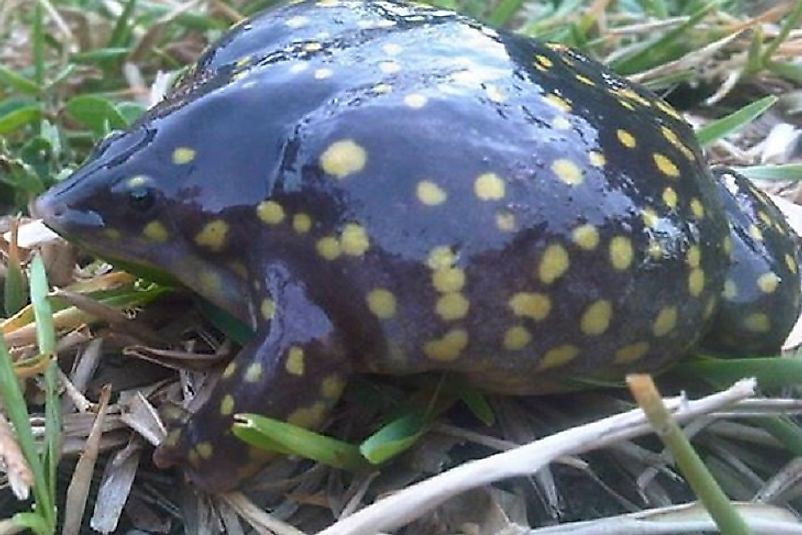Amphibians Of South Africa

South Africa is world famous for its flora and fauna, and widely known for the Kruger National Park, among other conservation areas. South Africa is currently the 27th country in the world regarding amphibian species richness, and is the fifth such country in its bio-geographical territory after Madagascar, the Democratic Republic of Congo, Cameroon, and Tanzania. The greatest richness of amphibians in South Africa is concentrated in the eastern part of the country covering KwaZulu-Natal. The amphibians in the country come in different shapes, sizes, and colors. The amphibians add beauty and biodiversity to the South African environment. Nature lovers are thrilled by these lovely creatures.
Western Leopard Toad
The Western Leopard Toad (Amietophrynus pantherinus) is a species native to South Africa in the areas of Cape Town and Agulhas Plain. The species is mainly found in residential suburbs. The Western Leopard Toad has beautifully marked hence the name. The toad’s breeding season is in August when thousands of toads migrate to suitable breeding grounds. The breeding areas include natural ponds, garden ponds, swamps, and urban watercourses. The females lay the eggs and males fertilize the eggs. The species is threatened by human development activities. Roads, buildings, and canals have taken up the toads’ breeding grounds. Volunteers have come to the rescue of the endangered species by helping the toads cross the roads during the breeding season. Road signs have also been put up to warn motorists against running over the toads.
Arum Frog
The Arum Frog (Hyperolius horstockii) is a South African native frog. It has cream to brown color with small black spots in some cases. The frog grows to an average length of 40 millimeters. It is found in ponds, swamps, rivers, and Mediterranean-type shrubby vegetation especially the arum lilies. The frog is threatened due to the destruction of its habitat. Urban expansion has destroyed the frog’s natural habitat. However, Arum frog can survive in harsh environments. Some of the areas where the frog inhabits are protected areas, such as the Table Mountain National Park.
Bronze Caco
The Bronze Caco (Cacosternum nanum) is a frog native to South Africa and Swaziland. It is a common species and occurs in a wide range of habitats including grasslands, savanna, forest areas, and urban areas. The frogs hide under logs and stones during the dry season and emerge in their thousands during heavy rains. The Bronze Caco is highly adaptable and is therefore not threatened. Furthermore, most of the areas the species inhabit are protected areas.
Spotted Snout-Burrower
The Spotted Snout-Burrower (Hemisus guttatus) is a frog species found in South Africa and Swaziland. Its habitat is in rivers, canals, ditches, moist savanna, temperate shrublands and temperate grasslands. It is a burrowing frog and mainly lives underground. The frog species is threatened by habitat loss. Urbanization, afforestation, and cultivation are some of the activities that threaten the frog’s existence. Research on the frog’s behavior, its population size, and trends is crucial to conservation efforts.
Table Mountain Ghost Frog
The Table Mountain Ghost Frog (Heleophryne rosei) is a native South African frog species. The species has a restricted range only inhabiting the southern and eastern slopes of the table mountain and the Western Cape Province. Its toad poles are delicate and develop in cold water over a 12 month period. The frog is said to be critically endangered species. Some of the factors that have contributed to the frog’s population decline are the construction of dams that alter the flow of water, afforestation, and habitat loss.
Understanding and Protecting South Africa's Amphibians
South Africa has a richness of amphibian species. In fact, it is ranked fifth among all African nations in terms of the highest diversity of amphibian species. The amphibians are part of the country’s natural wealth. In recent years, some of the species populations have significantly declined. It has been mainly attributed to destruction of their habitat by human development activities. Some of the species are said to be critically endangered. South African authorities have protected some of the areas where these creatures inhabit. Research on the amphibians’ populations, their habitats, and other aspects of their life is essential for the conservation of the animals.
Amphibians Of South Africa
| Amphibians of South Africa | Scientific Name |
|---|---|
| Western Leopard Toad | Amietophrynus pantherinus |
| Arum Frog | Hyperolius horstockii |
| Bronze Caco | Cacosternum nanum |
| Spotted Snout-Burrower | Hemisus guttatus |
| Table Mountain Ghost Frog | Heleophryne rosei |
| Cape Platanna | Xenopus gilli |
| Delalande's Sand Frog | Tomopterna delalandii |
| Paradise Toad | Vandijkophrynus robinsoni |
| Natal Ghost Frog | Hadromophryne natalensis |
| Landdros Moss Frog | Arthroleptella landdrosia |











